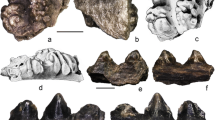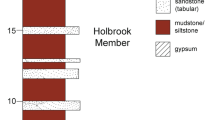Abstract
An association of trigonotarbid arachnids from Siegenian strata of Bürdenbach in the Westerwald is described. The Bürdenbach trigonotarbids are numerically dominated by a new genus and species, Spinocharinus steinmeyeri n. gen. n. sp., which is characterized by a rounded carapace with a unique pattern of thorn-like tubercles. A comparison with previously described Devonian trigonotarbids suggests that the new taxon is most probably assignable to the family Palaeocharinidae, which is well represented by the genus Palaeocharinus from the Scottish Rhynie cherts. This would constitute the first record of Palaeocharinidae from the Rhenish Devonian and contrasts sharply with previously described Emsian associations from the Rhenish Slate Mountains, which are dominated by archaeomartids. A rare archaeomartid, Archaeomartus cf. levis, occurs in association with the putative palaeocharinids.
Kurzfassung
Eine Assoziation trigonotarbider Spinnentiere aus dem Siegenium von Bürdenbach im Westerwald wird beschrieben. Diese Trigonotarbiden-Assoziation wird zahlenmäßig von einer neuen Art in einer neuen Gattung, Spinocharinus steinmeyeri n. gen. n. sp., dominiert, die durch einen abgerundeten Carapax mit einer einzigartigen Verzierung aus kräftigen, dornenartigen Tuberkeln charakterisiert wird. Ein Vergleich mit bereits bekannten devonischen Trigonotarbiden zeigt große morphologische Übereinstimmungen mit der Familie Palaeocharinidae, die insbesondere durch die Gattung Palaeocharinus aus den schottischen Rhynie Cherts gut bekannt ist. Dies würde den ersten Nachweis von Palaeochariniden für das Rheinische Devon darstellen und kontrastiert mit früher bekannt gewordenen Trigonotarbiden-Vergesellschaftungen aus dem Rheinischen Schiefergebirge mit einem Emsium-Alter, die von Archaeomartiden dominiert werden. In Assoziation mit den mutmaßlichen Palaeochariniden tritt der seltene Archaeomartide Archaeomartus cf. levis auf.






Similar content being viewed by others
References
Brauckmann, C. 1987. Neue Arachniden-Funde (Scorpionida, Trigonotarbida) aus dem westdeutschen Unter-Devon. Geologica et Palaeontologica 21: 73–85.
Brauckmann, C. 1994. Zwei neue Arachniden-Funde (Trigonotarbida) aus dem Unter-Devon der Eifel. Jahresberichte des naturwissenschaftlichen Vereins in Wuppertal 47: 168–173.
Dunlop, J.A. 1996a. A trigonotarbid arachnid from the Upper Silurian of Shropshire. Palaeontology 39: 605–614.
Dunlop, J.A. 1996b. Evidence for a sister group relationship between Ricinulei and Trigonotarbida. Bulletin of the British Arachnological Society 10: 193–204.
Dunlop, J.A. 2010. The enigmatic Pennsylvanian arachnids Areomartus ovatus and Vratislavia silesica (Trigonotarbida). Journal of Arachnology 38: 44–48.
Dunlop, J.A., and C. Brauckmann. 2006. A new trigonotarbid arachnid from the Coal Measures of Hagen-Vorhalle, Germany. Fossil Record 9: 130–136.
Dunlop, J.A., and M. Poschmann. 1997. On the Emsian (Lower Devonian) arthropods of the Rhenish Schiefergebirge: 1. Xenarachne, an enigmatic arachnid from Willwerath, Germany. Paläontologische Zeitschrift 71: 231–236.
Dunlop, J.A., and P.A. Selden. 2004. A trigonotarbid arachnid from the Lower Devonian of Tredomen, Wales. Palaeontology 47: 1469–1476.
Dunlop, J.A., C. Kamenz, and G. Talarico. 2009. A fossil trigonotarbid arachnid with a ricinuleid-like pedipalpal claw. Zoomorphology 128: 305–313.
Fayers, S.R., J.A. Dunlop, and N.H. Trewin. 2005. A new early Devonian trigonotarbid arachnid from the Windyfield chert, Rhynie, Scotland. Journal of Systematic Palaeontology 2: 269–284.
Fritsch, A. 1904. Palaeozoische Arachniden. Prag: Privately published.
Garwood, R.J., and J.A. Dunlop. 2010. Fossils explained 58. Trigonotarbids. Geology Today 26: 34–37.
Garwood, R.J., and J.A. Dunlop. 2011. Morphology and systematic of Anthracomartidae (Arachnida: Trigonotarbida). Palaeontology 54: 145–161.
Garwood, R., J.A. Dunlop, and M.D. Sutton. 2009. High-fidelity X-ray micro-tomography reconstruction of siderite-hosted Carboniferous arachnids. Biology Letters 5: 841–844.
Giribet, G., G.D. Edgecombe, W.C. Wheeler, and C. Babbitt. 2002. Phylogeny and systematic position of Opiliones: A combined analysis of chelicerate relationships using morphological and molecular data. Cladistics 18: 5–70.
Henke, W. 1930. Beiträge zur Klärung der Stratigraphie und Tektonik der Siegener Schichten zwischen Sieg und Rhein. Verhandlungen des Naturhistorischen Vereins der preußischen Rheinlande und Westfalens 86: 65–87.
Heymons, R. 1901. Die Entwicklungsgeschichte der Scolopender. Zoologica 33: 1–244.
Hirst, S. 1923. On some arachnid remains from the Old Red Sandstone (Rhynie Chert bed, Aberdeenshire). Annals and Magazine of Natural History 9: 455–474, 5 pls.
Jansen, U. 2008. Biostratigraphy and correlation of the traditional Emsian stage. 42–45. In Global alignments of Lower Devonian carbonate and clastic sequences (IGCP 499 project/SDS joint field meeting) August 25–September 3, 2008, ed. I.A. Kim, F.A. Salimova, and N.A. Meshchankina, 121. Uzbekistan. Contributions: Kitab State Geological Reserve.
Jeram, A.J., P.A. Selden, and D. Edwards. 1990. Land animals in the Silurian: arachnids and myriapods from Shropshire, England. Science 250: 658–661.
Müller, A.H. 1957. Ein Arachnidenrest (Brachylycosa? manebachensis n. sp.) aus dem Unteren Rotliegenden (Manebacher Schichten) von Thüringen. Geologie 6: 95–98.
Petrunkevitch, A.I. 1945. Paleozoic Arachnida of Illinois. An inquiry into their evolutionary trends. State of Illinois Scientific Papers 3: 1–72.
Petrunkevitch, A.I. 1949. A study of Palaeozoic Arachnida. Transactions of the Connecticut Academy of Arts and Sciences 37: 69–315, 83 pls.
Pocock, R.I. 1903a. A new Carboniferous arachnid. Geological Magazine 4(10): 247–251.
Pocock, R.I. 1903b. Further remarks on the Carboniferous arachnid Anthracosiro, with the description of a second species of the genus. Geological Magazine 4(10): 405–408.
Pocock, R.I. 1911. A monograph of the terrestrial Carboniferous Arachnida of Great Britain. Monograph of the Palaeontographical Society 1911(3): 1–84.
Poschmann, M. 2007. Nachweis des Seeskorpions Erieopterus (Chelicerata: Eurypterida) im Siegenium (Unterdevon) des Siegerlandes. Mainzer geowissenschaftliche Mitteilungen 35: 7–16.
Poschmann, M., and J.A. Dunlop. 2010. Trigonotarbid arachnids from the Lower Devonian (Lower Emsian) of Alken an der Mosel (Rhineland-Palatinate, SW-Germany). Paläontologische Zeitschrift 84: 467–484.
Poschmann, M., and U. Jansen. 2003. Lithologie und Fossilführung einiger Profile in den Siegen-Schichten (Unter-Devon) des Westerwaldes (Rheinisches Schiefergebirge). Senckenbergiana Lethaea 83: 157–183.
Poschmann, M., L.I. Anderson, and J.A. Dunlop. 2005. Chelicerate arthropods, including the oldest phalangiotarbid arachnid, from the Early Devonian (Siegenian) of the Rhenish Massif, Germany. Journal of Paleontology 79: 110–124.
Poschmann, M., J.A. Dunlop, C. Kamenz, and G. Scholtz. 2008. The Lower Devonian scorpion Waeringoscorpio and the respiratory nature of its filamentous structures, with the description of a new species from the Westerwald area, Germany. Paläontologische Zeitschrift 82: 420–438.
Rössler, R. 1998. Arachniden-Neufunde im mitteleuropäischen Unterkarbon bis Perm. Beitrag zur Revision der Familie Aphantomartidae Petrunkevitch 1945 (Arachnida, Trigonotarbida). Paläontologische Zeitschrift 72: 67–88.
Schultka, S. 1991. Trigonotarbus stoermeri n. sp.—ein Spinnentier aus den Bensberger Schichten (Ems/Unter-Devon) des Rheinischen Schiefergebirges. Neues Jahrbuch für Geologie und Paläontologie Abhandlungen 183: 375–390.
Selden, P.A., W.A. Shear, and P.M. Bonamo. 1991. A spider and other arachnids from the Devonian of New York, and reinterpretations of Devonian Araneae. Palaeontology 34: 241–281.
Selden, P.A., W.A. Shear, and M.D. Sutton. 2008. Fossil evidence for the origin of spider spinnerets, and a proposed arachnid order. Proceedings of the National Academy of Sciences of the USA 105: 20781–20785.
Shear, W.A. 2000. Gigantocharinus szatmaryi, a new trigonotarbid arachnid from the Late Devonian of North America (Chelicerata, Arachnida, Trigonotarbida). Journal of Paleontology 74: 25–31.
Shear, W.A., P.A. Selden, W.D.I. Rolfe, P.M. Bonamo, and J.D. Grierson. 1987. New terrestrial arachnids from the Devonian of Gilboa, New York (Arachnida, Trigonotarbida). American Museum Novitates 2901: 1–74.
Shultz, J.W. 2007. A phylogenetic analysis of the arachnid orders based on morphological characters. Zoological Journal of the Linnean Society 150: 221–265.
Stets, J., and A. Schäfer. 2002. Depositional Environments in the Lower Devonian Siliciclastics of the Rhenohercynian Basin (Rheinisches Schiefergebirge, W-Germany)—Case Studies and a Model. Contributions to Sedimentary Geology 22: 1–78.
Stets, J., and A. Schäfer. 2009. The Siegenian delta: Land-sea transitions at the northern margin of the Rhenohercynian basin. Geological Society, London, Special Publications 314: 37–72.
Størmer, L. 1970. Arthropods from the Lower Devonian (Lower Emsian) of Alken an der Mosel, Germany. Part 1: Arachnida. Senckenbergiana Lethaea 51: 335–369.
Wellman, C.H. 2004. Palaeoecology and palaeophytogeography of the Rhynie chert plants: Evidence from integrated analysis of in situ and dispersed spores. Proceedings of the Royal Society of London B 271: 985–992.
Yolkin, E.A., A.I. Kim, K. Wedigge, J.A. Talent, and M.R. House. 1997. Definition of the Pragian/Emsian Stage boundary. Episodes 20: 235–240.
Acknowledgments
We thank Peter Müller (Langenhahn) and Reinhard Steinmeyer (Koblenz) for useful discussions and for donating important fossils to a public collection. Without their enthusiasm this study would not have been possible. The thoughtful reviews by Russell Garwood (London) and an anonymous reviewer served to improve this contribution. MP thanks Michael Wuttke (Mainz) for his support.
Author information
Authors and Affiliations
Corresponding author
Rights and permissions
About this article
Cite this article
Poschmann, M., Dunlop, J.A. Trigonotarbid arachnids from the Lower Devonian (Siegenian) of Bürdenbach (Lahrbach Valley, Westerwald area, Rhenish Slate Mountains, Germany). Paläontol Z 85, 433–447 (2011). https://doi.org/10.1007/s12542-011-0109-x
Received:
Accepted:
Published:
Issue Date:
DOI: https://doi.org/10.1007/s12542-011-0109-x




